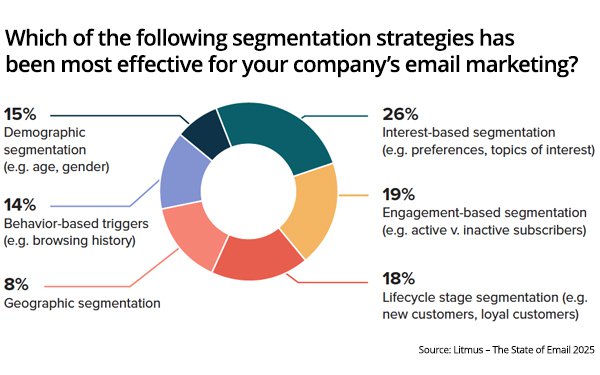
Email is a vital channel, but marketers need to invest in it,
especially in personnel, judging by The State of Email 2025, a study by Litmus from Validity.
Of the companies polled, 35% see an ROI of 36.1% or more and 9% get between 1:1
and 10:1. But many firms face hurdles in tracking ROI.
Indeed, the top roadblocks faced by email senders are:
- Difficulty in
measuring and/or proving ROI — 22%
- Low engagement rates — 20%
- Inadequate personnel devoted to email — 19%
Despite these issues, brands are investing in email, and it draws more of the average marketing budget than you might think:
- Less than 5% — 22%
- Between 5-10% — 31%
- Between 10-15% — 30%
- More than 15% — 12%
- I’m unsure —
5%
advertisement
advertisement
And the link between investment and success?
“Companies with the highest average email open rates (30-40%) are the most likely to dedicate
over 15% of their marketing budget to email marketing compared to those with lower email open rates, as are companies with the highest average click- through rates (over 5%),” the study
notes.
Part of this is also based on the number of personnel devoted to email marketing. Brands say they devote these percentages of their marketing budgets to people:
Less than
25% — 47%
Between 25% and 50% — 29%
Between 50% and 75% — 18%
More than 75% — 3%
Unsure — 3%
Here’s why it pays to invest in headcount:
“Companies that see higher ROI from email marketing (36:1 to 50:1) are most likely to have between 25% and 50% of their
marketing team dedicated to email,” the study reports. “Lower-ROI companies (1:1 to 10:1 and 10:1 to 36:1) are most likely to have less than 25% of headcount working on email. “
What about the top skill marketers seek when hiring? For 30%, the top skill is content creation.
Of course, there are also operational issues. Email senders face these
challenges:
- Improving benchmark metrics (open rate, CTR) — 25%
- Producing high-quality content efficiently — 19%
- Personalizing email content at scale — 16%
Meanwhile, brands are finding success with these segmentation strategies:
- Interest-based segmentation (e.g., preferences, topics of interest) — 26%
- Engagement-based segmentation (e.g., active v. inactive subscribers) —
19%
- Lifecycle stage segmentation (e.g., new customers, loyal customers — 18%
- Demographic segmentation (e.g. age, gender) —
15%
- Behavior-based triggers (e.g., browsing history) — 14%
- Geographic segmentation — 8%
When it comes to creative
tactics, 97% use at least one interactive element in their emails.
Which metrics do marketers rely on to track success? They utilize:
- Click-through rate (CTR)
— 29%
- Conversion rate — 24%
- Revenue generated from email campaigns — 17%
- Open rates — 15%
- Email deliverability rate — 10%
- Bounce rate — 4%
- Other — 1%
How
are they pulling? CTRs are now running at these levels:
- Less than 1% — 3%
- Between 1-3% — 30%
- Between 3-5% — 39%
- More than 5% — 23%
- Unsure — 5%
AI helps — 62% of
firms using AI-powered analytics tools have CTR of 3-5%, compared to 52% of companies that do not. Investments in headcount also drive higher rates.
“The brands seeing the
strongest email marketing results moved beyond traditional tactics to create sophisticated, data-driven programs that respond to individual customer needs,” says Cynthia Price, senior vice
president of marketing at Validity. “Successful marketing teams invest strategically in both technology and talent, recognizing email isn’t just a cost-effective channel— when
executed thoughtfully, it’s a high-performing business driver.”
Working with Datalily, Litmus surveyed 692 marketing professionals in the United States, United Kingdom,
Canada, Australia and Ireland from December 30, 2024-January 16, 2025, via Centiment.